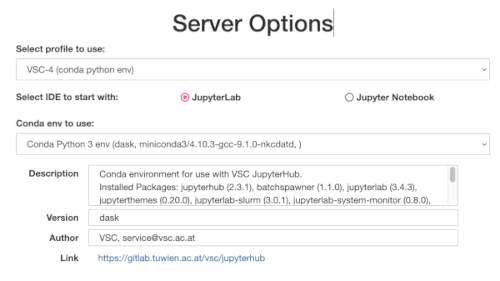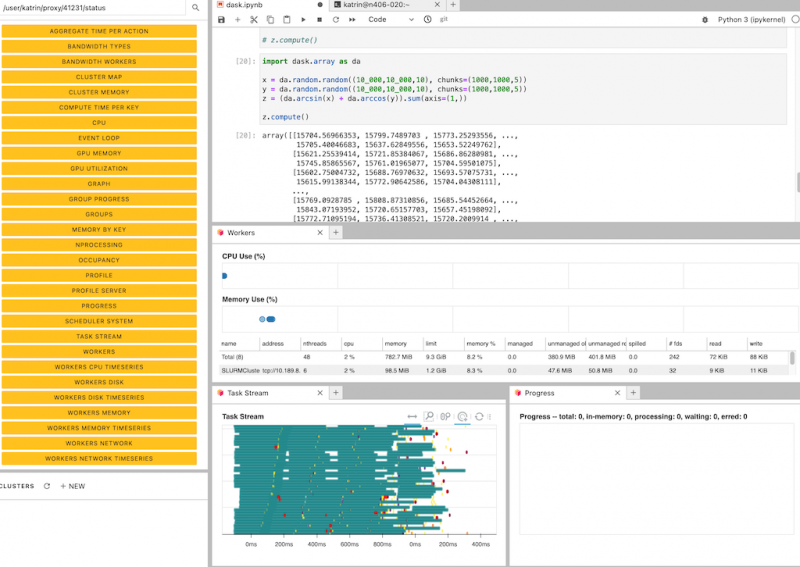 This version (2023/05/10 09:39) was approved by katrin.The Previously approved version (2022/08/24 07:32) is available.
This version (2023/05/10 09:39) was approved by katrin.The Previously approved version (2022/08/24 07:32) is available.
This is an old revision of the document!
Dask on JupyterHub
Profile & Environment
We have a prepared conda environment on VSC JupyterHub to use with dask.
Since we run updates in regular intervals the exact name vary. At the time of writing the most current name was jupyterhub-vsc-python-v1
Python Example
To properly use dask from the jupyterhub conda environment use the following code to get started
########################################################################## # if you are running on a shared node it is important to setup some dask variables # to not prevent interfering with other users dask setups (e.g. dashboard port ...) import os import dask import dask.config import dask.distributed USER = os.environ.get('USER') if USER.startswith('trainee'): user_number = int(USER.replace('trainee', '')) else: user_number = hash(USER) % 100 print('user_number:', user_number) DASHBOARD_PORT = 45000 + user_number SCHEDULER_PORT = 46000 + user_number ########################################################################### print('dashboard port:', DASHBOARD_PORT) print('scheduler port:', SCHEDULER_PORT) dask.config.set({'temporary_directory': f'/tmp/dask-{USER}'}) print('temporary directory:', dask.config.get('temporary_directory')) dask.config.set({'distributed.dashboard.link': f'/user/{USER}/proxy/{DASHBOARD_PORT}/status'}) print('dashboard link:', dask.config.get('distributed.dashboard.link'))
Info
For a complete and up 2 date list of configuration parameters have a look at the dask documentation: https://jobqueue.dask.org/en/latest/generated/dask_jobqueue.SLURMCluster.html
from dask_jobqueue import SLURMCluster cluster = SLURMCluster(queue='skylake_0096', # the slurm partition we want to use for dask-worker processes #account='p70824', # the account (=VSC project) used for accounting cores=16, # number of physical processor cores per SLURM job memory='4GB', # memory one SLURM job should have avaliable (will be divided by number of worker processes in job) processes=2, # number of dask-worker processes (=python processes) per SLURM job name=f'{USER}-worker', # custom name of dask-workers (used in dask internally) walltime='00:30:00', # time a SLURM job will run for e.g. 30 minutes; after that all dask-worker in the job will shutdown interface='ib0', # ib0 is the name of the fast network connection on VSC-4 & VSC-5 scheduler_options={ 'interface': 'ib0', # scheduler should also use ib0 'port': SCHEDULER_PORT, # custom scheduler port (dask-worker processes will use this to connect) 'dashboard_address': f':{DASHBOARD_PORT}', # custom dashboard port from earlier }, # if you use adaptive scaling you might want to set these as well # see https://jobqueue.dask.org/en/latest/advanced-tips-and-tricks.html#how-to-handle-job-queueing-system-walltime-killing-workers #worker_extra_args=[ # '--lifetime', '25m', # '--lifetime-stagger', '5m' #], job_directives_skip=[ '-J dask-worker', # skip the default SLURM job name ], job_extra_directives=[ f'--job-name={USER}-worker', # set a custom SLURM job name '--qos=skylake_0096', # set e.g. a custom qos that provides you with faster scheduling #'--reservation=training', # an optional reservation to use ]) # the settings from above are turned into a slurm job script that can be # displayed for debugging by using the 'job_script' method print(cluster.job_script())
After running the above code you have a cluster instance that holds the dask scheduler and all the information to spawn dask-worker processes that will actually execute the generated tasks. So far no worker processes have been spawned yet. You can always check this by running
$ squeue -u $USER
The next step we need to take is now to scale up the cluster to get some worker processes running. In dask there are two options available:
- scale: scale the cluster to a fixed number of jobs (or workers) depending on the arguments
- adapt: set minimum and maximum number of jobs and the cluster handles scaling according to the current load
Since they are scheduled via SLURM it depends heavily on your resource settings from earlier how long it will take to get them scheduled and be in a running state.
# use 'scale' to schedule a fixed number of slurm jobs that host dask-worker processes cluster.scale(jobs=1) # OR use 'adapt' to use adaptive scaling #cluster.adapt(minimum_jobs=1, maximum_jobs=10) # call the 'get_logs' function to see if everything is ok cluster.get_logs()
After executing the above code using scale you should see jobs appearing in slurm that are called '<username>-worker'
$ squeue -u $USER
JOBID PARTITION NAME USER ST TIME NODES NODELIST(REASON)
475376 skylake_0096 user-wor user R 0:22 1 n4902-030
The next step is important: here we create a dask distributed client that uses the cluster instance.
From this point on all scheduled tasks will be sent to the cluster for execution
from dask.distributed import Client client = Client(cluster)
After the slurm jobs with the worker processes are running we can finally schedule some work via dask:
import dask.array as da x = da.random.random((1000, 1000, 10), chunks=(1000, 1000, 5)) y = da.random.random((1000, 1000, 10), chunks=(1000, 1000, 5)) z = (da.arcsin(x) + da.arccos(y)).sum(axis=(1,)) z.compute()
To cleanup resources one can close client & cluster and delete the references. By doing this everything related to those instances will be freed as well.
client.close() del client cluster.close() del cluster

